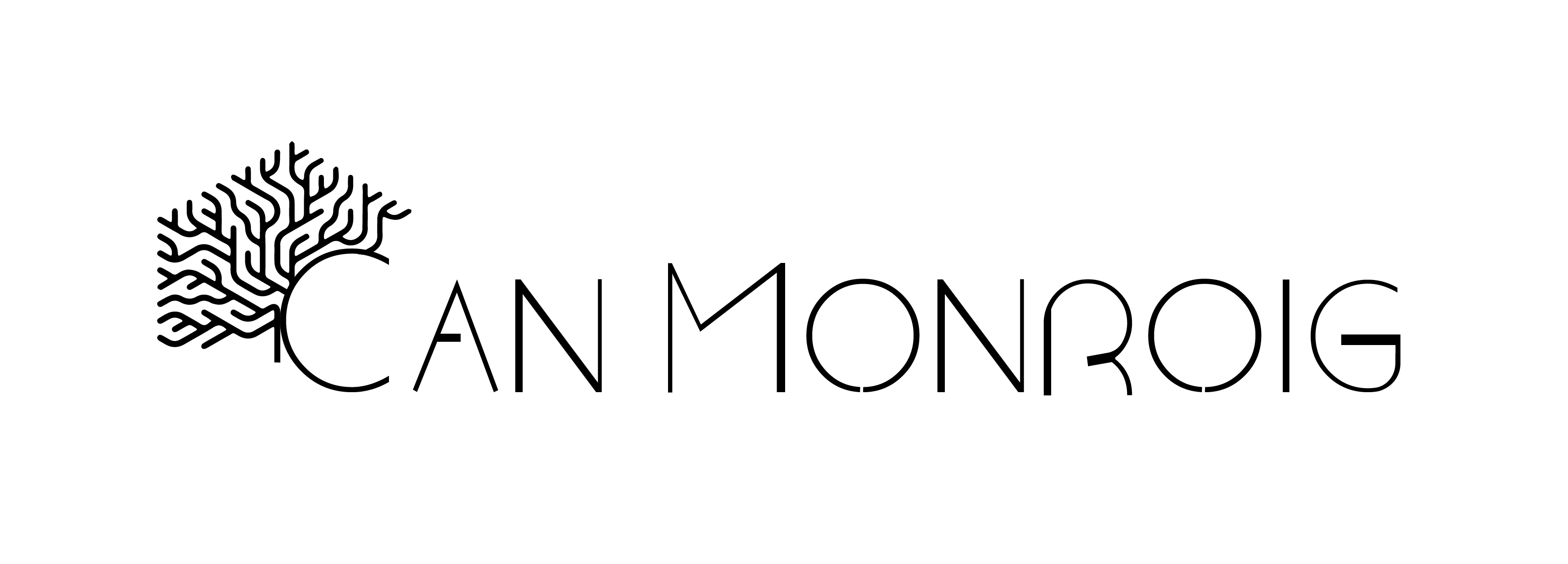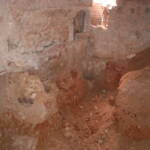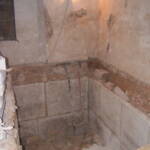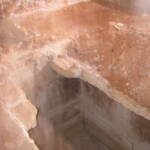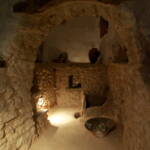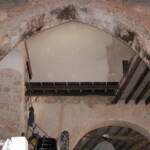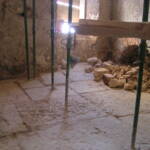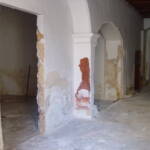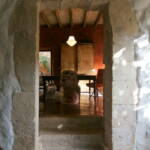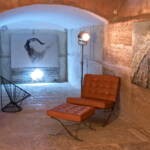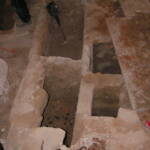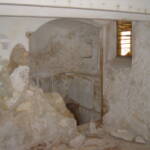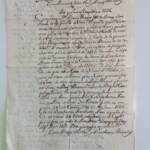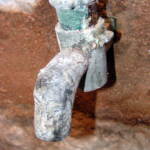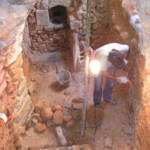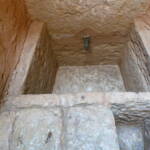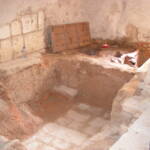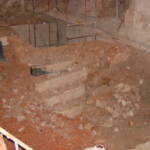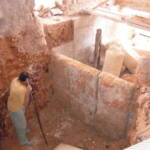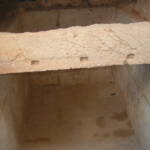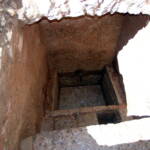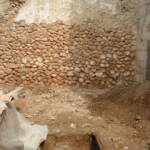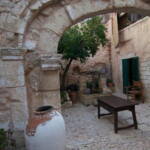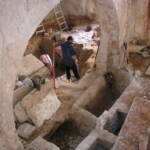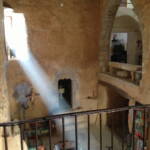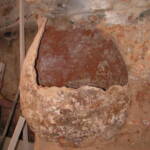
Can Monroig It is situated at 22 carrer de Can Valella and has also been known as Can Móra. This building is located in the Inca's Jewish neighborhood which was formed within Sant Francesc, Virtud, Can Valella, Pare Cerdà, Call streets.
The current two-floor house is dated from the 16th century and it has a smooth façade decorated with little stones, similar to the façade of Can Siquier. The openings are formed by multiple windows, except for the main entrance which is finished with a round arch made of stone similar to the bottom of the façade. As well as in the mentioned Can Siquier, inside Can Monroig there are some remains of Baroque style as handle-shaped arches.
This house was closed for many years and with the passage of time it had deteriorated. Some years ago it was bought and its new owners restored it which came to light many architectural elements which highlighted the medieval origin of the house. The gothic elements of the building that can be seen today are formed by some pointed and rounded arches, and an entrance and a window both right angled. Thus, the inside of the house consists of two bays. In the first bay, there are three rooms which are perpendicular to the front separated by arches. It is in the space that can be considered the entrance of the house, where there is a Baroque handle-shaped arch and another round and white arch that leads to a room where there is a pointed arch, currently it is bricked-in.
The first bay is separated by a second wall which opens an access formed by a right angle entrance between two bays, and on its right, a window formed with a round arch can possibly be dated from the Medieval Age because of the resemblance to other entrances and windows from other Gothic buildings of the same time (Palau de l'Almudaina in Palma, Palau dels Reis de Mallorca in Sineu, Torre dels Enagistes in Manacor, etc.). It is also possible that in previous time these windows would have been an entrance.
In the second bay on the left wall there is a stone entrance with a right angle and a wooden lintel, then a square window and another entrance, now finished with a right angle, but originally it was finished with a rounded arch, like the one situated in the separating wall between the two bays. For their shape and situation, we think they are also medieval remains.
At the back of the house, is found a courtyard, before to the left there is a space opened by a handle-shaped baroque arch, which in its interior we can observe the remains of another older handle-shaped arch. There is a previous one, much older, one can still be seen in its place which is made of stone and it was pointed. In addition, to the right, you can still see the start of what must have been the beginning of the nerve crossing of the vault remains. On the opposite of the arch, the remains of the pointed one are still visible and with the width of the space, one might think that it was a space covered by two tranches of vault.
Once discovered, these architectural remains were taking dated back to the Jewish area in the 14th century, where the house is located. It is easy to think that we talk about Gothic that probably dates from this century or even from the 13thth.
In addition to these findings, the restorations of the house have replaced all the stone floors and made a number of interesting findings. Also, note to the right of the entrance, is found an old oven placed below the level of the street, as well as a whole series of stone vats and tanks scattered throughout the house connected through clay pipes. In addition, we know that the house also has a wine cellar and a cistern is still preserved.
In the courtyard there are two tanks, one larger than the other. Inside the smaller, some steps were discovered by which it was possible to access into it and inside there is a bronze tap with anthropomorphic decoration (two eyes and a nose).
Unlike the various arches formed by the architectural remains, in the case of the findings of the oven, the various tanks, cisterns and wells, we are unable to date them, because until now they have not been studied by archaeologists and, therefore, we have no convincing data that allows us to know what its use was or when they were built. Also, keep in mind that Can Monroig is a house that has undergone many changes and additions over the centuries, which makes further study necessary.
But, however repeat some dates are important enough which, in the future, and after a good archaeological study, could help to decipher these different findings.
So one again, we notice that the house is located in the area which, in the 14th century, was the Jewish area of Inca. Therefore, we believe it necessary to note some bibliographic data on Jews in Majorca, Inca and on the erection of our Jewish area, without forgetting Palma's Jewish area too.
Inca's Jewish Quarter
We must seek the origins of the Jewish presence in Majorca in the fifth century, both in Mallorca and Menorca, as well documented by a letter from Bishop Sever in 417 BC. Also, thanks to several sources, we know that during the Islamic domination of the island (902-1229) there was also a significant Jewish community. So, when Jaume I conquered Mallorca in 1229, he not only found a significant Jewish settlement in Palma, but also in other parts of the island including Inca, Petra, Montuïri, Felanitx, Sineu, Alcúdia, Sóller and Pollença.
The Jewish community of Inca was already in 1232, when Jaume I granted remuneration to the Jews of Inca, Almudaina de Gomara (Palma), Petra and Montuïri. A 1240 document confirms the presence of Jews in Inca. Furthermore, the Conqueror gave his support to the Jews of Mallorca granting them the privilege of Royal protection confirmed by him in 1247.
We have more information about the Jewish community of Inca comprising the fourteenth century. This data is documented in the Morabati books of 1329 and 1336. We also know that in recent years the Inca Jews still didn't have an area to live together, but they lived scattered over different parts of the town. Instead, they had a good organization under a Jewish institution known as Aljama, which was approved by the king and had counsellors, secretaries and attorneys, as well as enjoying some public independence.
Due to the significant and constant clashes in 1346 between some members of the Jewish and Christian communities King Peter IV of Aragon gave the order to raise a Jewish quarter within the town of Inca. Despite the royal decree, and because of the large decline in the Jewish population after the plague of 1348, it was not until 1372 when a Jewish quarter was definitively settled in Inca. Although in 1353 the Judges had asked the governor where the Jewish quarter would be placed and it was assigned in the district of Saint Bartholomew, specifically in the Martí Metge Street, but the Jews did not like the site because of the poor condition of the houses, many of them in a state of ruin, and appealed to the king to grant them another place to settle. Finally, King Peter IV of Aragon, as we have seen, in 1372 gave them the new and current, place located in Pascolet street Found in the district of Saint Francis.
The assault on the Jewish quarter in 1391
The Jewish quarter of Inca, similar to the case of Palma, was surrounded by a wall and closed by two gates, one of them was in the Sant Francesc street. It is confirmed in the documents of 1372 where the Jews asked for a gate to be built on the Sant Francesc street. However, Jews were told their own district be as closed to the rest of the town was enough to stop the fighting and assaults on Jewish houses by Christians and in 1391 they assaulted the Jewish quarters of Palma and Inca. Christians brought out by various disturbances which perpetrated numerous acts of looting and destruction, the killing of a large number of Jews (regarding Inca; the documents speak of an almost total extinction) and they set fire to houses and shops within the Jewish quarter, leaving the entire neighborhood devastated.
Returning to Can Monroig…
As a conclusion, and having the house of Can Monroig located where the Jewish quarter once was, one last observation leads to the pointed arch that places us at the entrance of the house. In this arch, at the top, it is still possible to see the remains of burnet stone and a photograph of the same arch made just before cleaning, shows us the remains of a fire had. In the second bay of the house, even after a post that gives access to the left, there is another entrance showing the wooden lintel completely burnet.
Text: Guillem Reus Planells
More information:
Jewish quarter of Inca (blog)
Jewish quarter of Inca (Google plus)
Can Monroig and the Jewish quarter of Inca (pinterest)
Mallorca Newspaper about
